Here's a complete guide to feeding your degus vegetables, including what types, how much and how often (and for those picky degus, how).
Jump to Vegetable List


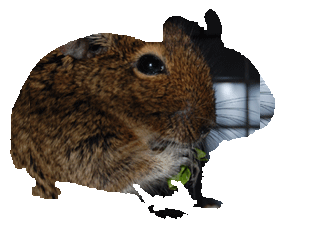
Here's a complete guide to feeding your degus vegetables, including what types, how much and how often (and for those picky degus, how).
Jump to Vegetable List
>Why the need for fresh veg?<
Fresh vegetable matter is an important part of the diet of all herbivorous animals. While hard feed includes all the vitamins and minerals your degus are likely to need that they cannot extract from hay, there are certain essential nutrients that are vital to the body's health, which feed manufacturers are unable to incorporate into dry feed due to their natural instability. Fresh vegetable matter, however, is packed full of these important nutrients (which include essential amino acids and essential fatty acids) in a form readily available when ingested. Without these nutrients, your degus can develop any number of health problems related to deficits in the body, including poor skin, hair loss and even neurological problems in severe cases. Fresh veg is really important!
>How much veg should I give?<
Although it is important that your degus have regular access to fresh vegetable matter, too much of it can lead to other problems such as bloating and
diarrhoea, both of which are very uncomfortable for your degus. Therefore getting the right balance is the key.
1. Chop your veg into small bits roughly the size of your thumb nail. Remember degus have small stomachs, but it is still good to give them a selection
of veg to choose from (see below).
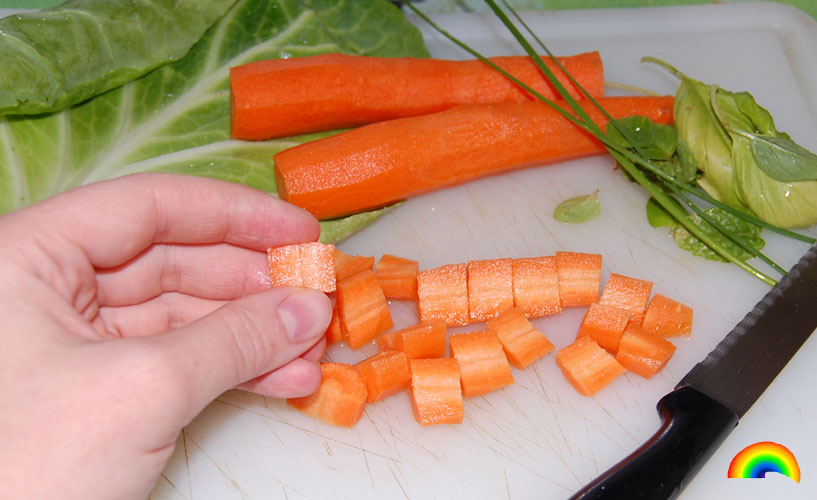
2. Divide your fresh veg between the degus' feed bowls, so you can keep an eye on how much and what sorts of veg each degu is eating. Not all degus
like all veg, so a varied selection is the way to go. A good size portion for one degu is shown in the picture below. This veg dish contains carrot,
cabbage, peas and fresh herbs (mint, chives, oregano and basil).
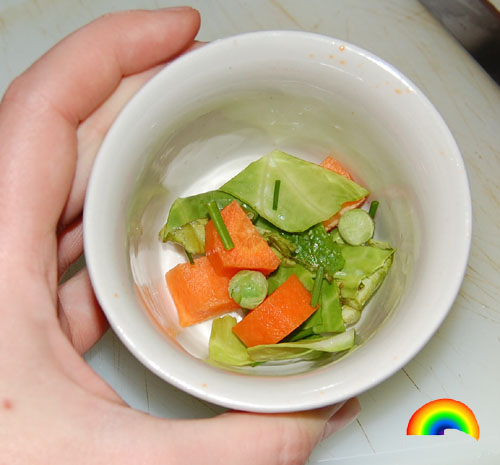
3. If your degus are very picky about what veg they eat (if any), try mixing your veg with fresh or dried herbs (degus love the smell and taste) and a
sprinkle of natural, rolled oats. The picture below shows a picky veg eater's dish, with a dried rose petal to get them interested. Note that you should
always give your degus access to different veg each week, even if they never want to try it (you never know- they might suddenly develop a taste for
green beans as two of our boys did!). You can also try them with dried vegetables to get them started, or mix them in with fresh veg.

4. You should offer your degus a fresh veg selection like this once or twice each week, but not more often than this. Remember that green veg in
particular is likely to cause bloating, so alternate the types of veg in each session to avoid this (refer to the veg list below).


^Pip investigating the veg (cautiously), and Dreggen tucking into a dried rose petal (best bit first!).

^Poppy filling her face!
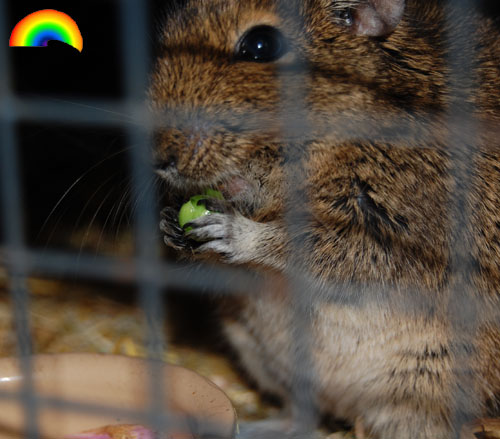
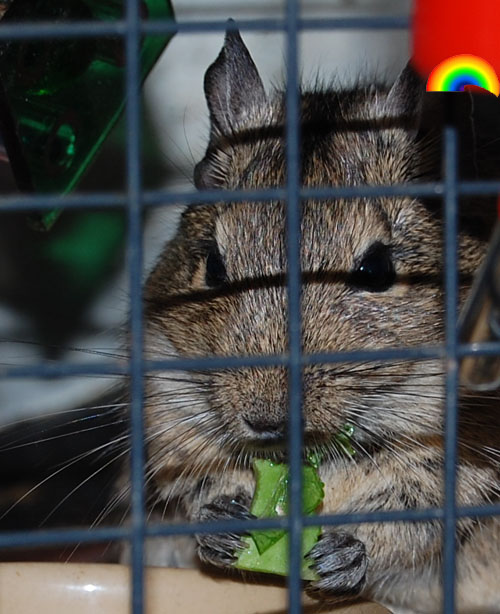
^Lilly enjoying a pea, and Chibi munching on some cabbage.
TOP TIP: In the summer, try giving your degus some veggies such as peas or green beans straight from the freezer. These are great for keeping
your degus cool, but spray the veg with water first to prevent freezer burn.
>List of Vegetables Suitable for Degus<
*Please note that all store-bought veg should be washed thoroughly to remove chemicals prior to feeding. Feeding sugar-containing veg matter should be done on a monthly basis to allow the degus time to metabolise the sugars. There may be some degu-suitable veg missing from the list- if you think a vegetable should be on the list, please get in touch!
|
Vegetables that need to be fed in moderation to avoid bloating |
Vegetables that are higher in natural sugars and should only be given once per month (note that diabetic degus should not be given these) |
Other vegetables that may be given weekly to degus |
| Cabbage
(all types, including savoy, red, summer, white, etc)
Broccoli Swede Green beans Fresh grass Dandelion leaves Fresh herbs (oregano; mint; parsley; basil; chives; comfrey; lemon balm; coriander) Carrot tops Cauliflower (leaves and stalk) Courgette Leek Asparagus Celery Brussels sprouts Lettuce |
Peas
Carrots Sweet potato (raw or cooked) Apple Cucumber Cherry tomato Sweetcorn/maize/corn on the cob |
Butternut
squash
Pumpkin Marigold flowers Dried herbs (oregano; mint; parsley; basil; chives; comfrey; lemon balm; coriander) Red pepper, green pepper Radish Spring onion Dried rose petals Rosehips Beetroot (note: can give urine a red/brown tinge!) |